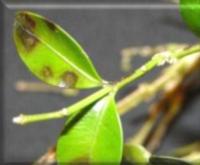Boxwood Blight
-
Buxus is a genus of about 70 species in the family Buxaceae. Common names include box (majority of English-speaking countries) or boxwood (North America). Boxwood is quite easy to propagate and grow and is very common in western gardens for hedges and natural effects. However, one new disease of concern is boxwood blight, a fungal disease caused by Cylindrocladium buxicola.
In the mid-1990’s, plant pathologists in the United Kingdom first identified the fungal disease. It is now found throughout Europe. By 2002, boxwood blight was present in New Zealand. How the fungus arrived in the United States is unclear, but within 2011, it has been found in 8 eastern states as well as in Oregon (December 2011). To date boxwood blight is known to infect all species of boxwood, Buxus spp. and Pachysandra spp., in landscapes, garden centers, and nurseries.
Boxwoods infected with the boxwood blight fungus first develop tan leaf spots with a dark brown border. Chalky white spores form on the lower surface of the leaf just below leaf spots, under humid conditions. Leaf spots grow large enough to blight the entire leaf. Infected leaves fall off, resulting in bare branches throughout the shrub. The fungus also infects branches anywhere from the soil line to the tip of the branch. These infections start out as dark brown to black short lines, and grow to completely encircle and girdle the stem. Roots of the boxwood shrub are not infected by the fungus and remain healthy.
The most susceptible species appear to be English (Buxus sempervirens ‘Suffruticosa’) and American or common boxwood (B. sempervirens), although many species of boxwood are susceptible to infection. Asymptomatic but infected plants of resistant varieties may introduce this pathogen to uninfected areas.The fungus colonizes all aboveground portions of the plant. Initial symptoms appear as dark or light brown circular leaf spots. Infected leaves then turn brown-tan, which is rapidly followed by defoliation. In addition, black lesions often develop on twigs and stems.
In Connecticut, Boxwood blight has been reported to occur on all commercial Buxus species, although some species and cultivars appear to be more susceptible than others.
There are a number of steps that can be taken to prevent the spread of the blight:
• Inspect new plants and cuttings; only buy from reputable nurseries.
• Isolate them for at least one month, longer if possible.
• Avoid overhead watering.
• Don't work with wet boxwood.
• Never compost infected material.
• If you see or suspect an infected plant:
- Remove the whole plant and put it in a plastic bag. Do not carry it near to uninfected plants.
- Consult with a county agent or other expert to confirm the diagnosis. In California, contact your county agricultural commissioner.
• Consider replanting with plants other than boxwood.There is no known cure. Fungicides may prevent the spread of the disease. To be effective, they must be applied to the entire plant, leaves and stems. This can be difficult because boxwood leaves are very closely spaced.
Since this is a new disease, research is ongoing. There are a few places to find out current information, including: The Connecticut Agricultural Experiment Station Plant Disease Information Office The American Nursery & Landscape Association (ANLA) boxwood blight website , North Carolina State University boxwood blight links page, and the Oregon Boxwood Blight Pest Alert.
Reference:
Western Plant Diagnostic Network
First Detector News
Fall 2012 edition, volume 5, number 3

